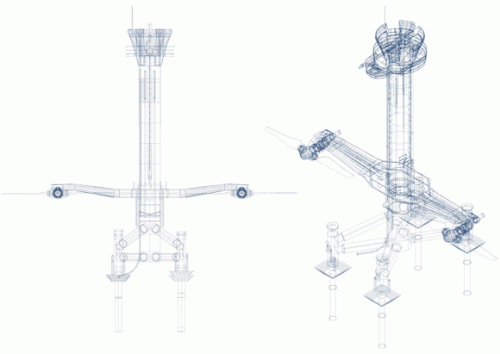Tidal power isn’t new: the barrage on the Rance near Saint-Malo in Brittany has been generating useful power since 1966. But estuary dams have drawbacks: you sacrifice other uses, you get silting, and each project is bespoke. But a project in Northern Ireland now seems to have moved tidal power from the pigeon-hole “useful, niche, experimental” to “large-scale, replicable, near-commercial”.
It’s significant that the company, Marine Current Turbines, set up in 1999, is now a fully-owned subsidiary of the unsentimental giant Siemens, with no time for lost causes.
There are no really helpful photos on the company website, but here’s a CAD drawing that gives the idea:

The marine turbine is, to a first crude approximation, a floating wind turbine upended in the water like a feeding duck. The rotors can be winched up the central shaft for maintenance.
Siemens/MCT seem to have solved the reliability issues that plague wave power; tidal environments tend to be somewhat sheltered, and the vulnerable rotors are safely below the surface. The Rance barrage has a decent capacity factor of 40%, higher than wind and solar but lower than geothermal or conventional. The availability shifts round the clock like the tides, which isn’t ideal for matching demand. But as the tides are 100% predictable, and generation varies smoothly along a sinusoidal curve, the problem must be very much easier to manage than the noisier intermittency of wind and solar, and makes a mixed system more resilient.
The worldwide potential for tidal energy has been guesstimated at 90GW. Interactive map and report on tidal potential from Georgia Tech for the US coastline.
The important point for the economics is that the design is a standardised piece of kit, largely manufactured off-site, which can therefore benefit from economies of scale and learning. Which we will only get provided that a critical number of governments provide infant-industry subsidies (FITs or tax credits) to take us along the curve. Nova Scotia can’t do it by itself.
Japan, currently planning its own huge Energiewende away from oil and nuclear, is nibbling at tidal as a component of the new energy mix with another vendor. My guess is that it will scale up rapidly assuming the demonstration works.
Jerriais - the sadly extinct Jersey dialect of Norman-French - had a specific word for the difference between high and low water: le puognant, if I recall rightly. This matters in Jersey where the range can be 10 or 30 feet. I commend the word to tidal engineers.
I had to look up the title phrase. I think the reason I don’t have that poem nearer the forefront of my memory is that I don’t know how to pronounce “not” and “naught” so there’s a difference. “Say naught the struggle not availeth” doesn’t have quite the same flourish of fustian.
If we actually draw those 90GW from the tides, would we slow down the moon?
Vance: If we actually draw those 90GW from the tides, would we slow down the moon?
That sounds like an XKCD comic waiting to be drawn. 🙂
We would indeed slow down the moon, which would mess with the heads of Muslims as their calendar is lunar, but not Jews or Chinese, whose lunar calendars are solar-adjusted. There might also be some trouble with scheduling the rapture, and this should be carefully investigated.
The politics of energy are very complicated.
Wel, if we can work out daylight savings time not waking the cows up too late to be milked (a problem solved everywhere but Saskatchewan, I think), then we should be able to handle the tidal/lunar problem.
I’ve had a similar question about (massive) windpower projects that ship their electricity long distances. Ultimately, we are transferring (large amounts of?) heat from one region to another. How does this effect local climates? We’ve already had many experiments of releasing large amounts of heat locally, esp. in cities, and I’m not aware of any discussions (certainly none that I can understand) of how that has affected climates around cities, beyond a bit saying the long temperature records have to be recalibrated as areas around them have become increasingly built up. What would happen to the steppe climate of the Great Plains if we turned them into a giant wind farm?
I had an exchange in comments with the lamented Brett Bellmore a while back but can’t find it. As I recall, there are local effects from wind farms as they mix colder and warmer air streams from different heights, but nothing to worry about. The global effects become perceptible above 18 TW, the order of magnitude of total current world energy use. So not quite a free lunch, and worth checking out.
PS: New research reported here saying much the same thing. If you harvested 1800 TW using not-yet-invented high atmospheric turbines everywhere, you would change the climate. At a piddling 18 TW, mean global temperature rises 0.1 degC, precipitation +/- 1%.
Required reading on slowing down the moon: “The Last Judgment” by J.B.S. Haldane
Dixit Wikipedia, tidal friction has slowed the length of the day by 126 minutes in 60 million years, or 0.000002 minutes (0.00012 seconds) a day per year. My linked source for tidal power potential thinks that only 3% of tidal energy can be extracted for electricity because of siting constraints - you need a deep bay or fiord, not a straight shore. So in the worst case where the tidal turbines don’t replace natural friction at all, you might slow the Earth by 0.0000036 additional seconds a day.
Corrections to my arithmetic welcome.
That’s a relief. Turbines full speed ahead!
If anything it would slow the rotation of the Earth, not the moon. But of course, it is a trivial amount of energy compared to the Earth’s kinetic energy.
Your arithmetic is correct. By the way, I love the units: minutes per day per year.
Of course if Bill O’Reilly is right, the tides are inexplicable except by supernatural intervention. It could be dangerous to interfere; we might annoy Pau Amma.
